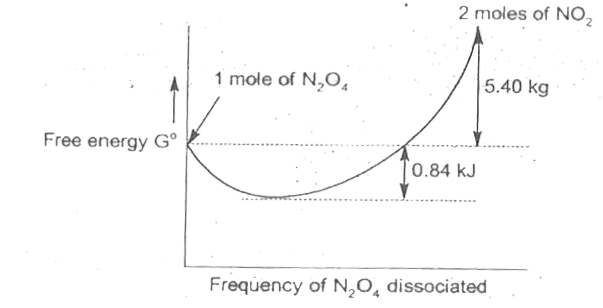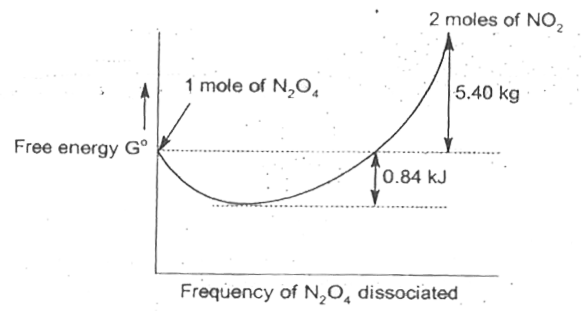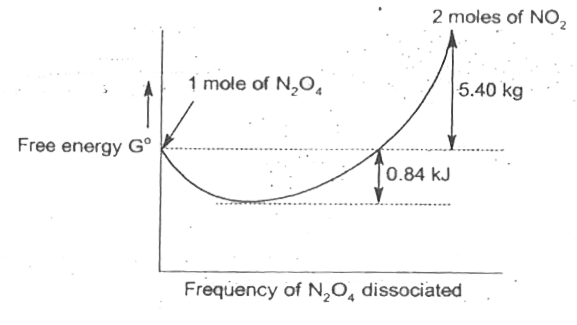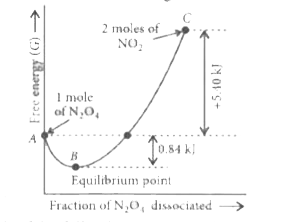A reaction is spontaneous if free energy change ΔG , for the reaction is negative . The question arises, how we can explain , the spontaneous of reversible reaction taking the example of dissociation equilibrium N2O4⇔2NO2(g) the variation of free energy with the fraction of N2O4 dissociated under standard conditions is shown in the figure below.

The standard free energy change for the conversion of 1 mole of N2O4 into 2 moles of NO2 is
5.40 KJ
−5.40KJ
(5.4+0.84 )KJ
(5.40 +2 ×0.84)kJ
The correct Answer is:A
ΔG=G for 2 moles of NO−2−G for 1 mole of N2O4
=5.40 kJ
Topper's Solved these Questions
- CHEMICAL EQUILIBRIUMBOOK - FIITJEECHAPTER - CHEMICAL EQUILIBRIUMEXERCISE - MATRIX -MATCH TYPE QUESTION
1 Videos
- CHEMICAL EQUILIBRIUMBOOK - FIITJEECHAPTER - CHEMICAL EQUILIBRIUMEXERCISE - REASONING TYPE QUESTION
1 Videos
- CHEMICAL EQUILIBRIUMBOOK - FIITJEECHAPTER - CHEMICAL EQUILIBRIUMEXERCISE - SOLVED PROBLEMS (OBJECTIVE)
18 Videos
- CHEMICAL ENERGETICS BOOK - FIITJEECHAPTER - CHEMICAL ENERGETICS EXERCISE - NUMERICAL BASED QUESTIONS
2 Videos
- CHEMICAL KINETICS AND RADIOACTIVITYBOOK - FIITJEECHAPTER - CHEMICAL KINETICS AND RADIOACTIVITYEXERCISE - Exercise
9 Videos
Similar Questions
A reaction is spontaneous if free energy change ΔG , for the reaction is negative .
The question arises, how we can explain , the spontaneous reversible reaction taking the example of dissociation equilibrium ,N2O4⇔2NO2(g).
the variation of free energy with the fraction of N2O4 dissociated under standard conditions is shown in the figure below.

The standard free energy change for the conversion of 1 mole of N2O4 into 2 moles of NO2 is
View SolutionA reaction is spontaneous if free energy change ΔG , for the reaction is negative . The question arises, how we can explain , the spontaneous of reversible reaction taking the example of dissociation equilibrium N2O4⇔2NO2(g) the variation of free energy with the fraction of N2O4 dissociated under standard conditions is shown in the figure below.

When 2 moles of NO2 change into equilibrium mixture the value of ΔG∘ is
View Solution
Knowledge Check
A reaction is spontaneous if free energy change ΔG , for the reaction is negative . The question arises, how we can explain , the spontaneous of reversible reaction taking the example of dissociation equilibrium N2O4⇔2NO2(g) the variation of free energy with the fraction of N2O4 dissociated under standard conditions is shown in the figure below.

When 1 mole of N2O4 changes into the equilibrium mixture the volume of ΔG∘ isA0.84 kJB−0.84kJC5.40 0.84 kJD0.84-5.40 kJA reaction is spontaneous if free energy change ΔG , for the reaction is negative . The question arises, how we can explain, the spontaneous of reversible reaction taking the example of dissociation equilibrium N2O4⇔2NO2(g) the variation of free energy with the fraction of N2O4 dissociated under standard conditions is shown in the figure below.

When 2 moles of NO2 change into equilibrium mixture the value of ΔG∘ isA(5.40+0.84)kJB(5.40−0.84)kJC(−5.40−0.84)kJD−5.40kJFor a spontaneous chemical process, the free energy change is
APositiveBNegativeCZeroDCan be positive or negative
A reaction is spontaneous if free energy change ΔG for the reaction is negative . The question arises, how we can explain , the spontaneous reversible reaction. Taking the example of dissociation equilibrium N2O4⇔2NO2(g) the variation of free energy with the fraction of N2O4 dissociated under standard conditions is shown in the figure below.

When 1 mole of N2O4 changes into the equilibrium mixture the value of ΔG∘ is
View SolutionHow does free energy change explain the criterion of spontaneity?
View SolutionFor a chemical reaction, the free energy change (ΔG) is negative. The reaction is
View SolutionFor the dissociation equilibrium,
N2O4(g)⇔2NO2(g), the variation of free energy with the fraction of N2O4 dissociated under standard conditions is shown in the figure :

Which of the following statements is/are correct?
View SolutionIf equilibrium constant for a reaction is K, then standard free energy change is :
View Solution
